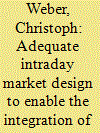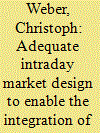|
|
|
Sort Order |
|
|
|
Items / Page
|
|
|
|
|
|
|
| Srl | Item |
| 1 |
ID:
096614


|
|
|
|
|
| Publication |
2010.
|
| Summary/Abstract |
This contribution analyses the European electricity markets with respect to their aptitude to absorb large amounts of wind energy. Thereby in a first step the market designs of the major European power markets in France, Germany, Scandinavia, Spain and UK are reviewed, with a particular focus on liquidity in the spot and intraday markets. Then some key features of the short-term adjustments required by wind energy are discussed and the necessity of sufficient liquidity in intraday markets is highlighted. For the example of the German market subsequently the discrepancy between the physical short-term adjustment needs and the traded volumes on the intraday market is analyzed. This leads to an evaluation of proposals for improving the liquidity on the short-term market, including the use of continuous spot trading like in UK or the use of intraday auctions like in Spain.
|
|
|
|
|
|
|
|
|
|
|
|
|
|
|
|
| 2 |
ID:
097457


|
|
|
|
|
| Publication |
2010.
|
| Summary/Abstract |
This contribution analyses the European electricity markets with respect to their aptitude to absorb large amounts of wind energy. Thereby in a first step the market designs of the major European power markets in France, Germany, Scandinavia, Spain and UK are reviewed, with a particular focus on liquidity in the spot and intraday markets. Then some key features of the short-term adjustments required by wind energy are discussed and the necessity of sufficient liquidity in intraday markets is highlighted. For the example of the German market subsequently the discrepancy between the physical short-term adjustment needs and the traded volumes on the intraday market is analyzed. This leads to an evaluation of proposals for improving the liquidity on the short-term market, including the use of continuous spot trading like in UK or the use of intraday auctions like in Spain.
|
|
|
|
|
|
|
|
|
|
|
|
|
|
|
|
| 3 |
ID:
125399


|
|
|
|
|
| Publication |
2013.
|
| Summary/Abstract |
Growing climate change and energy security concerns are driving major wind energy deployment in electricity industries around the world. Despite its many advantages, growing penetrations of this highly variable and somewhat unpredictable energy source pose new challenges for electricity industry operation. One issue receiving growing attention is the so-called 'merit order effect' of wind generation in wholesale electricity markets. Wind has very low operating costs and therefore tends to displace higher cost conventional generation from market dispatch, reducing both wholesale prices and conventional plant outputs. This paper extends the current literature on this effect through an empirical study employing a range of econometric techniques to quantify the impacts of growing wind penetrations in the Australian National Electricity Market (NEM). The results suggest that wind is having a marked impact on spot market prices and, while wind is primarily offsetting higher operating cost gas generation, it is now also significantly reducing dispatch of emissions intensive brown coal generation. Great care needs to be taken in extrapolating these results to longer-term implications, however, the study does propose a methodology for assessing this effect, highlights the impacts that wind is already having on NEM outcomes and suggests promising directions for future research.
|
|
|
|
|
|
|
|
|
|
|
|
|
|
|
|
| 4 |
ID:
150718


|
|
|
|
|
| Summary/Abstract |
Over the last decade there have been a growing number of federal and state regulations aimed at controlling air emissions at power plants and/or increasing the penetration of renewable resources in the grid. Environmental Protection Agency regulations will likely lead to the retrofit, retirement, or replacement of coal-fired power plants while the state Renewable Portfolio Standards will continue to drive large-scale deployment of renewable energy sources, primarily wind. Combined, these changes in the generation fleet could have profound implications for the operations of the power system. In this paper, we aim to better understand the interaction between coal plant retirements and increased levels of wind power. We extensively analyze the operations of the PJM electricity system under a broad set of scenarios that include varying levels of wind penetration and coal plant retirements. Not surprisingly, we find that without transmission upgrades, retirement of coal-fired power plants will likely result in considerable transmission congestion and higher energy prices. Increased wind penetration, with high geographic diversity, could mitigate some of the negative effects of coal plant retirement and lead to a significant reduction in air emissions, but wind forecast error might impose operational constraints on the system at times of peak load.
|
|
|
|
|
|
|
|
|
|
|
|
|
|
|
|
| 5 |
ID:
097461


|
|
|
|
|
| Publication |
2010.
|
| Summary/Abstract |
Integrating wind generation into power systems and wholesale electricity markets presents unique challenges due to the characteristics of wind power, including its limited dispatchability, variability in generation, difficulty in forecasting resource availability, and the geographic location of wind resources. Texas has had to deal with many of these issues beginning in 2002 when it restructured its electricity industry and introduced aggressive renewable portfolio standards that helped spur major investments in wind generation. In this paper we discuss the issues that have arisen in designing market protocols that take account of these special characteristics of wind generation and survey the regulatory and market rules that have been developed in Texas. We discuss the perverse incentives some of the rules gave wind generators to overschedule generation in order to receive balancing energy payments, and steps that have been taken to mitigate those incentive effects. Finally, we discuss more recent steps taken by the market operator and regulators to ensure transmission capacity is available for new wind generators that are expected to come online in the future.
|
|
|
|
|
|
|
|
|
|
|
|
|
|
|
|
| 6 |
ID:
096619


|
|
|
|
|
| Publication |
2010.
|
| Summary/Abstract |
Integrating wind generation into power systems and wholesale electricity markets presents unique challenges due to the characteristics of wind power, including its limited dispatchability, variability in generation, difficulty in forecasting resource availability, and the geographic location of wind resources. Texas has had to deal with many of these issues beginning in 2002 when it restructured its electricity industry and introduced aggressive renewable portfolio standards that helped spur major investments in wind generation. In this paper we discuss the issues that have arisen in designing market protocols that take account of these special characteristics of wind generation and survey the regulatory and market rules that have been developed in Texas. We discuss the perverse incentives some of the rules gave wind generators to overschedule generation in order to receive balancing energy payments, and steps that have been taken to mitigate those incentive effects. Finally, we discuss more recent steps taken by the market operator and regulators to ensure transmission capacity is available for new wind generators that are expected to come online in the future.
|
|
|
|
|
|
|
|
|
|
|
|
|
|
|
|
|
|
|
|
|